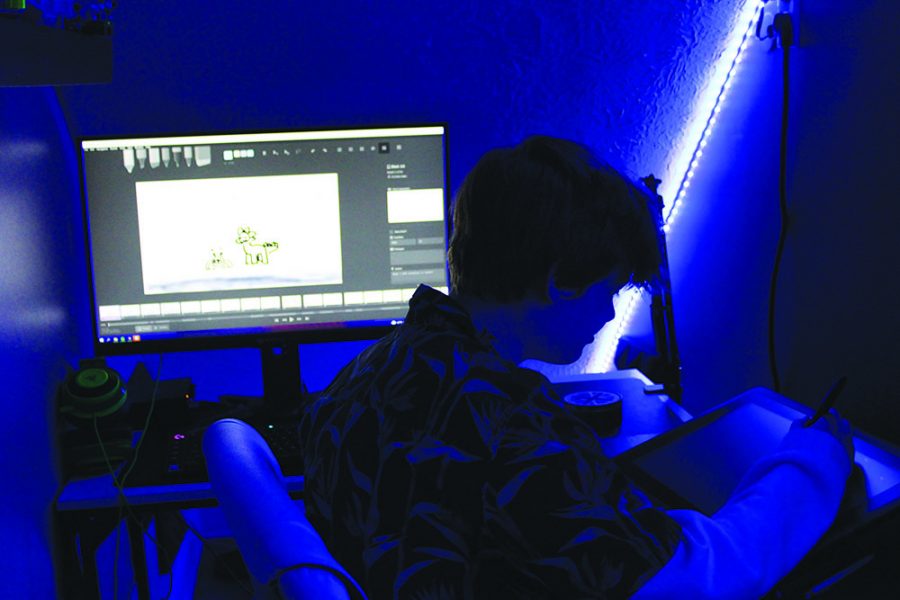The hit Disney XD show “Gravity Falls” played a major role in sophomore Ren Olson’s future career choice. Olson said the show and its artwork drew him toward animation when he was in middle school, and he’s kept at it since.
“I’m a fan of Alex Hirsch (creator of ‘Gravity Falls’), I love his work––it’s so awesome. I watched it when it first came out, and I’ve seen all the episodes at least 10 times. I was just obsessed with it. I was like, ‘This guy is really cool, and I want to do what he does,’” he said.
“I’d already been drawing at that point for three or four years, and I googled (Hirsch) and watched YouTube videos about him, and I was like ‘Animation––this is so cool.’ I really liked it, and I really got into it, and I watched a lot of animated music videos on YouTube made by other kids or young adults, and I got into looking at college thesis films,” he said. “That was when I was around 12, and ever since then that’s what I’ve wanted to do.”
Olson is one of many students, both here and elsewhere, who hopes to work as an animator after college. According to the Bureau of Labor Statistics, the Special Effects and Animation Artists industry is expected to grow by 16% this decade. Many of these aspiring animators, like Olson, drew influences from famous animators and animation studios such as Disney and Cartoon Network.
Digital Design teacher Michael Lee, who teaches many fundamentals of animation in his class, said he agreed famous animators have an impact on student art.
“I would imagine that any art I come across will influence my art in some way. I create art by drawing from life experiences and observations,” Lee said via email. “These studio companies are very impressive in what they produce.”

Since studios such as Disney have an extremely wide audience, with the subscription service Disney+ having over 116 million subscribers as of August, the animation content they produce can impact animation projects and designs for years to come.
“Disney totally has a monopoly on the animation field right now,” Olson said. “I’m not going to deny it. Like Cartoon Network and Sony Animation, they’re the only two that have a chance at this point, but I think Disney has really stepped up their game in the past few years.”
For sophomore Sarah Xie, Disney has provided them with two of their favorite animated shows thus far: “Amphibia” and “The Owl House.”
“I do watch a lot of animated shows, especially TV shows. I find them really relaxing and it reminds me of my childhood,” Xie said. “I do think that Disney influenced a lot of animation along with a lot of other companies.”
“I think animation itself, it’s getting a lot better,” they added, “and as time goes on, the animation will look a lot more realistic and maybe become even more popular than reality TV shows.”
Olson said he agreed. “There’s so many things you can do with animation that you can’t do in real life, and of course animation is sparked off of real life, but there are some things that are truly incredible in animation that can’t be done in real life,” he said.
For budding student animators, Olson recommended experimenting with different tools and apps such as Flipaclip, which you can use to make frame-by-frame animation videos, and encouraged them to pursue their dreams and be confident in themselves.
He said, “The first step is trying it, really. You don’t have to be great to make an animation because there’s so many different styles of it, and you can have it really simplified. For (example), you could just have a circle, and that’s your character. And you can make a whole story out of that. So never let your technical skill define you, and never let not knowing stuff define you.
“I’ve had a ton of adults come up to me and be like, ‘Being an animator, that’s not something that’s really attainable, you can’t really do that,’” he added, “and I was like, ‘Yes I can,’ and I started doing it. Every animator starts with an idea. And as long as you have that idea and you’re driven enough to do it, there’s nobody that can stop you.”


































![AI in films like "The Brutalist" is convenient, but shouldn’t take priority [opinion]](https://hilite.org/wp-content/uploads/2025/02/catherine-cover-1200x471.jpg)










































![Review: “The Immortal Soul Salvage Yard:” A criminally underrated poetry collection [MUSE]](https://hilite.org/wp-content/uploads/2025/03/71cju6TvqmL._AC_UF10001000_QL80_.jpg)
![Review: "Dog Man" is Unapologetically Chaotic [MUSE]](https://hilite.org/wp-content/uploads/2025/03/dogman-1200x700.jpg)
![Review: "Ne Zha 2": The WeChat family reunion I didn’t know I needed [MUSE]](https://hilite.org/wp-content/uploads/2025/03/unnamed-4.png)
![Review in Print: Maripaz Villar brings a delightfully unique style to the world of WEBTOON [MUSE]](https://hilite.org/wp-content/uploads/2023/12/maripazcover-1200x960.jpg)
![Review: “The Sword of Kaigen” is a masterpiece [MUSE]](https://hilite.org/wp-content/uploads/2023/11/Screenshot-2023-11-26-201051.png)
![Review: Gateron Oil Kings, great linear switches, okay price [MUSE]](https://hilite.org/wp-content/uploads/2023/11/Screenshot-2023-11-26-200553.png)
![Review: “A Haunting in Venice” is a significant improvement from other Agatha Christie adaptations [MUSE]](https://hilite.org/wp-content/uploads/2023/11/e7ee2938a6d422669771bce6d8088521.jpg)
![Review: A Thanksgiving story from elementary school, still just as interesting [MUSE]](https://hilite.org/wp-content/uploads/2023/11/Screenshot-2023-11-26-195514-987x1200.png)
![Review: "When I Fly Towards You", cute, uplifting youth drama [MUSE]](https://hilite.org/wp-content/uploads/2023/09/When-I-Fly-Towards-You-Chinese-drama.png)
![Postcards from Muse: Hawaii Travel Diary [MUSE]](https://hilite.org/wp-content/uploads/2023/09/My-project-1-1200x1200.jpg)
![Review: "Ladybug & Cat Noir: The Movie," departure from original show [MUSE]](https://hilite.org/wp-content/uploads/2023/09/Ladybug__Cat_Noir_-_The_Movie_poster.jpg)
![Review in Print: "Hidden Love" is the cute, uplifting drama everyone needs [MUSE]](https://hilite.org/wp-content/uploads/2023/09/hiddenlovecover-e1693597208225-1030x1200.png)
![Review in Print: "Heartstopper" is the heartwarming queer romance we all need [MUSE]](https://hilite.org/wp-content/uploads/2023/08/museheartstoppercover-1200x654.png)




